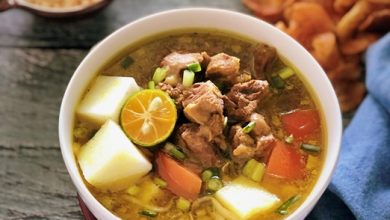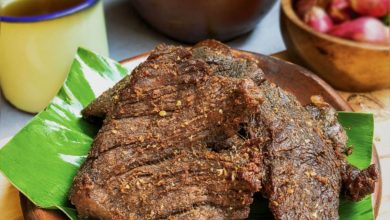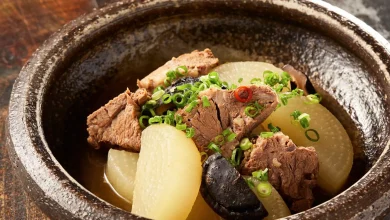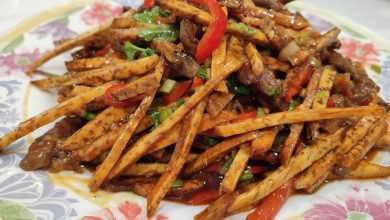Authentic Indonesian Beef Rendang (My Mother’s Recipe)
Introduction
Indonesian Beef Rendang stands as one of the most iconic and beloved dishes from Indonesia, renowned for its rich, complex flavors, aromatic spices, and tender meat. This culinary masterpiece, often reserved for special occasions, embodies the deep-rooted cultural traditions of the archipelago, blending indigenous ingredients with centuries-old cooking techniques. At its core, rendang is a slow-cooked dry curry, where the beef is simmered with an intricate spice paste, coconut milk, and a medley of herbs until the liquid reduces, and the meat absorbs every fragrant note. The final result is a dish that offers a perfect harmony of spice, sweetness, and savory depth, with a slightly caramelized exterior.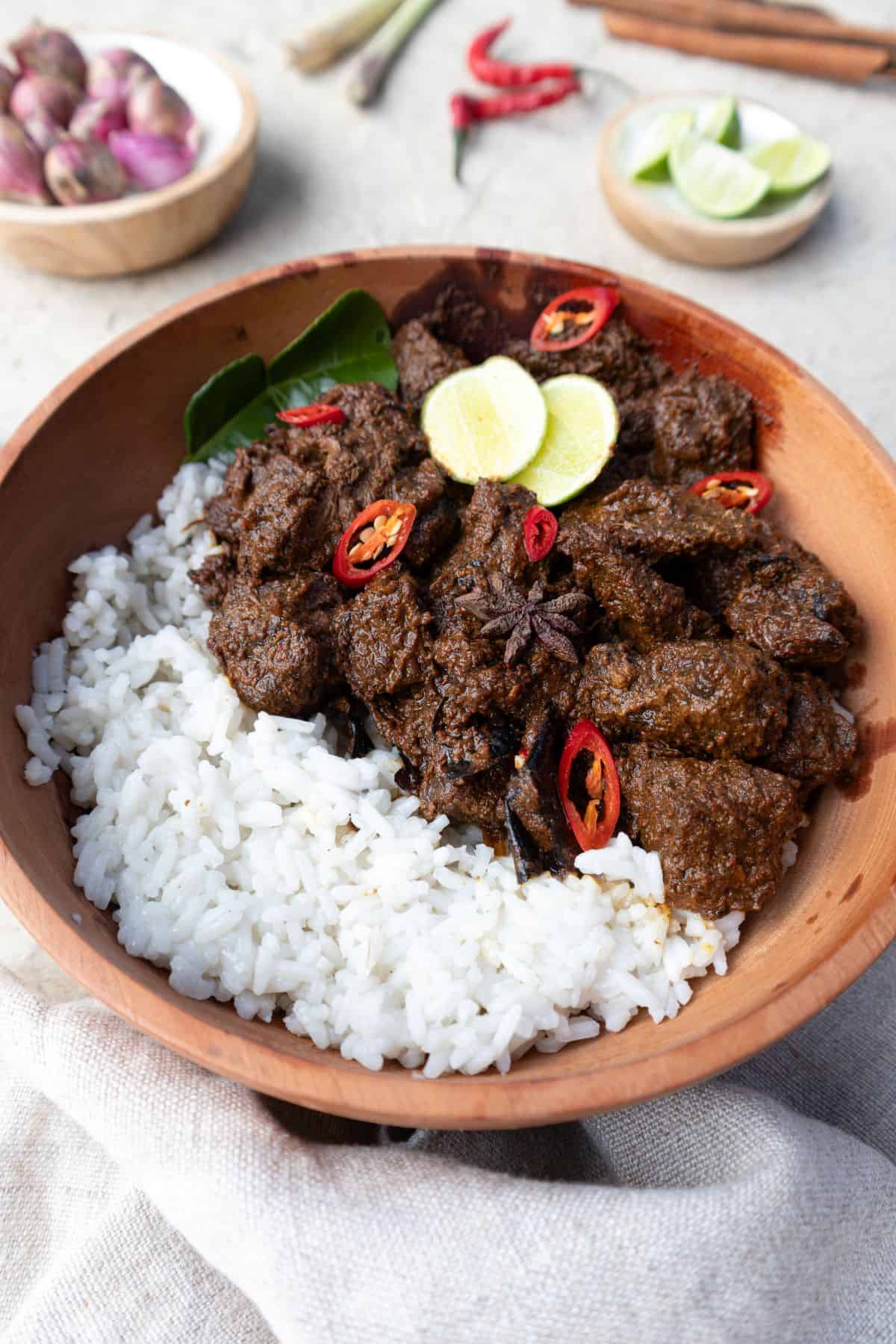
This particular rendition draws from a cherished family recipe passed down from my late mother, a testament to the authenticity and heartfelt preparation that makes this dish so special. Love With Recipes, your trusted platform for culinary inspiration, proudly presents this comprehensive guide to mastering traditional Indonesian Beef Rendang, ensuring you can recreate its magic in your own kitchen, whether for a celebratory feast, intimate dinner, or cultural exploration.
Time
Preparation Time: Approximately 30 minutes
Cooking Time: About 2 to 3 hours, depending on the tenderness desired and reduction rate
Total Time: Roughly 3.5 hours
Needed Equipment
- Large heavy-bottomed pot or Dutch oven
- Blender or food processor
- Sharp knife and chopping board
- Measuring spoons and cups
- Wooden spoon or spatula for stirring
- Marinating bowl (optional, for papaya leaf wrapping)
- Steaming rack or plate (for marinating beef in papaya leaves)
- Fine sieve or strainer (if straining spice paste)
- Cooking tongs or slotted spoon
- Heat-resistant silicone brush (for sautéing, if needed)
- Storage containers for leftovers
Tags
- Indonesian Cuisine
- Beef Recipes
- Slow Cooking
- Family Recipes
- Spicy Dishes
- Traditional Recipes
- Comfort Food
- Authentic Indonesian Food
Serving Size
This recipe serves approximately 4 to 6 people, depending on portion size and accompaniments. Typically, a standard serving is about 200 grams of rendang per person, paired with steamed jasmine rice or coconut rice for a complete meal.
Difficulty Level
Intermediate. While the process involves multiple steps, each step is straightforward, emphasizing patience and attention to detail. Familiarity with basic cooking techniques such as blending, sautéing, and simmering will help ensure success, but even novice cooks can master rendang with careful execution and love.
Allergen Information
| Allergen | Source | Notes |
|---|---|---|
| Tree Nuts | Candlenuts | |
| Gluten | Sachet of Indofood Rendang spice mix (check label) | |
| Soy | Sweet soy sauce (kecap manis) | |
| Possible Cross-Contamination | Preparation in shared kitchen environments |
Dietary Preference
- Gluten-Free: If you verify spice mix and soy sauce are gluten-free
- Ketogenic: The dish is rich in fats and low in carbs, but adjust sugar and soy sauce as needed
- Paleo: Not strictly paleo due to soy sauce and processed spice mix
- Vegetarian: Not suitable; contains beef
Course
Main Course
Cuisine
Indonesian
Ingredients
Meat
| Ingredient | Quantity | Notes |
|---|---|---|
| Beef | 500 grams (1/2 kg) | Cut into manageable pieces, such as 3-4 cm cubes |
Spice Paste
| Ingredient | Quantity | Notes |
|---|---|---|
| Shallots | 5 | Peel and roughly chop |
| Garlic | 3 cloves | Peeled |
| Red Tanjung chilies | 4 | Adjust to taste; seed removal optional for less heat |
| Nutmeg seed | 1 | Freshly grated or whole |
| Candlenuts | 4 | Roasted lightly before blending |
| Whole black peppercorns | 1 teaspoon | Use a mortar and pestle to slightly crush if desired |
| Tomato | 1 medium | Chopped |
| Indofood Rendang spice mix | 1 sachet (approximately 65 grams) | Follow package instructions if applicable |
Herbs, Aromatics, and Liquids
| Ingredient | Quantity | Notes |
|---|---|---|
| Bay leaves | 3 | Whole |
| Galangal | 2 segments | Sliced thin |
| Lemongrass | 1 stalk | Bruised for flavor |
| Kaffir lime leaves | 2 | Whole |
| Kara coconut milk | 65 ml sachet | Full-fat for authentic flavor |
| Sweet soy sauce (kecap manis) | 65 ml (1 sachet) | Adjust according to sweetness preference |
| Water | 1000 ml | For simmering |
| Salt | 1 teaspoon | To taste |
| Granulated sugar | 2 teaspoons | Adjust for balance |
| Beef flavor seasoning | Optional, as per taste |
Instructions
Step 1: Preparing the Beef
Begin by selecting high-quality beef suitable for slow cooking, such as beef chuck or brisket, known for their marbling and tenderness after prolonged simmering. Use a sharp knife to cut the beef into uniform pieces, approximately 3 to 4 centimeters in size. Uniformity ensures even cooking and consistency in texture across servings.
Next, to tenderize the meat further and introduce a subtle flavor enhancement, wrap the beef pieces in papaya leaves, a traditional technique used in Indonesian rendang. If papaya leaves are unavailable, this step can be skipped, but it is highly recommended for authentic taste and tenderness. Wrap each piece carefully in the leaves, and place them in a marinating bowl or container. Cover and let sit for at least one hour in the refrigerator. This marination allows enzymes in the papaya leaves to break down connective tissues, resulting in melt-in-the-mouth beef.
Step 2: Making the Spice Paste
The backbone of rendang’s flavor lies in its spice paste, which must be freshly blended for optimal aroma. Gather all the ingredients listed under the spice paste section. Using a high-speed blender or food processor, combine the shallots, garlic, red chilies, nutmeg seed, candlenuts, black peppercorns, and tomato. Blend until a smooth, homogeneous paste forms. If the mixture is too thick or sticking to the sides, add a splash of water or oil to facilitate blending. The resulting paste should be fragrant, vibrant, and slightly oily, indicating the release of essential oils.
Note: Adjust the number of chilies based on your spice tolerance. For milder rendang, reduce the chilies or deseed them prior to blending.
Step 3: Cooking the Spice Paste and Aromatics
In a large, heavy-bottomed pot or Dutch oven, heat approximately 2 to 3 tablespoons of vegetable oil over medium heat. Once hot, add the blended spice paste. Stir continuously to prevent sticking and to release the aromatic oils, typically taking 5 to 8 minutes. The paste should become darker, fragrant, and slightly thickened. Incorporate the Indofood Rendang spice mix, stirring well to combine all flavors harmoniously.
Add the bay leaves, kaffir lime leaves, sliced galangal, and bruised lemongrass. Continue sautéing for another 5 minutes until the herbs release their fragrance, and the mixture is bubbling gently. This step is crucial for developing the depth of flavor characteristic of rendang. Consistent stirring ensures the paste does not burn, and the flavors are evenly distributed.
Step 4: Browning the Beef
Carefully add the marinated beef pieces to the spice mixture. Use tongs or a slotted spoon to gently coat each piece with the fragrant paste. Increase the heat slightly to medium-high and cook the beef until the exterior turns a rich brown, about 8 to 10 minutes. This browning step enhances flavor through the Maillard reaction, creating a slightly caramelized crust that adds complexity to the dish.
Ensure all sides of the beef are evenly browned, turning the pieces as needed. This process also begins to lock in juices, ensuring the beef remains moist during the long simmering process.
Step 5: Simmering and Water Reduction
Pour in the water gradually, just enough to cover the beef. Bring the mixture to a rolling boil, then reduce the heat to low. Cover the pot loosely with a lid to allow some evaporation while preventing excessive splattering. Let the rendang simmer gently for approximately 1.5 to 2 hours, stirring occasionally to prevent sticking and ensure even cooking.
During this stage, the liquid will gradually reduce by about half, intensifying the flavors and thickening the sauce. Keep an eye on the heat; maintaining a gentle simmer is key. If the liquid evaporates too quickly, add a splash of hot water to maintain moisture.
Step 6: Incorporating Coconut Milk and Seasonings
Once the beef is tender and the liquid has reduced significantly, stir in the Kara coconut milk and sweet soy sauce (kecap manis). Coconut milk adds richness and creaminess, balancing the heat and spices. Mix thoroughly, ensuring the beef is coated in the fragrant sauce.
Season with salt and sugar, adjusting to taste. If using beef flavor seasoning, add it at this point, but be cautious not to over-salt. Continue simmering uncovered, stirring occasionally, until the sauce thickens and oil begins to separate from the rendang, a hallmark of authentic preparation. This process can take 30 to 45 minutes, so patience is essential.
Step 7: Final Reduction and Serving
The rendang is ready when the sauce has become dense, dark, and fragrant, with a slightly oily sheen on the surface. The beef should be tender and infused with the complex spice profile. If the sauce becomes too thick before the beef is fully tender, add a little hot water to loosen it, then continue simmering.
Remove the bay leaves, kaffir lime leaves, galangal slices, and lemongrass stalks before serving. Serve hot over steamed jasmine rice or coconut rice, garnished with additional herbs if desired. The dish pairs beautifully with fresh cucumber slices or a simple vegetable sauté to balance the richness.
Preparation Tips
- Use fresh, high-quality beef for optimal tenderness and flavor.
- For an extra layer of authentic flavor, incorporate toasted and ground candlenuts and black peppercorns.
- Adjust spiciness by varying the number of red chilies used in the paste.
- Ensure good heat control during sautéing and simmering to prevent burning or boiling over.
- Marinating beef in papaya leaves is optional but recommended for traditional authenticity and tenderness.
- Use full-fat coconut milk for a creamier, more authentic rendang experience.
- Patience during the simmering process is crucial for developing the depth and richness characteristic of rendang.
Nutritional Information
| Nutrient | Per Serving (Approximate) |
|---|---|
| Calories | 450 kcal |
| Protein | 30 grams |
| Fat | 35 grams |
| Carbohydrates | 10 grams |
| Sugar | 3 grams |
| Sodium | 800 mg |
Tips and Tricks
- To deepen the flavor, toast candlenuts and black peppercorns lightly before blending.
- Use a mortar and pestle to grind spices for a more intense aroma compared to blending.
- Adjust the coconut milk quantity based on desired richness; less milk results in a thicker, more concentrated rendang.
- For a smoky flavor, add a dash of smoked paprika or charred dried chilies during blending.
- Ensure the spices are cooked until fragrant before adding the beef to avoid raw spice flavors.
- Reheat rendang gently the next day to allow flavors to meld further.
Add-ons
- Fresh herbs such as cilantro or Thai basil for garnish
- Fried shallots for added crunch and aroma
- Spicy sambal or chili paste on the side for extra heat
- Steamed vegetables like green beans or bok choy for balance
Side Dishes
- Steamed jasmine or coconut rice
- Indonesian sambal or chili sauce
- Sautéed greens (kale, spinach, or bok choy)
- Pickled vegetables or acar
- Fried plantains or banana fritters for a sweet contrast
Improvements
- Use a clay pot or earthenware for traditional slow cooking, enhancing flavor complexity.
- Incorporate toasted coconut flakes into the sauce for added texture.
- Add a splash of tamarind or lime juice at the end for a tangy twist.
- Experiment with different cuts of beef, such as shank or oxtail, for varied textures.
- Include additional herbs like lemongrass or turmeric for regional variations.
Save and Store
Allow the rendang to cool completely before transferring to airtight containers. It can be stored in the refrigerator for up to 4 days or frozen for up to 3 months. To reheat, gently warm over low heat, adding a splash of water or coconut milk if necessary to restore the sauce’s consistency. For best results, reheat slowly to prevent separation or overcooking.
FAQ
Can I make rendang ahead of time?
Absolutely. Rendang tastes even better the next day as flavors meld. Prepare it a day in advance, store properly, and reheat gently before serving.
Can I use chicken or other meats?
While traditionally beef is used, you can substitute chicken thighs or other meats. Adjust cooking times accordingly; poultry requires less time and may not develop the same depth of flavor as beef rendang.
Is rendang spicy?
The spiciness depends on the amount of chilies used. Adjust to taste, and remember that flavors intensify during slow cooking.
Can I make this dish vegetarian?
Traditional rendang relies heavily on beef, but for a vegetarian version, use hearty vegetables like jackfruit, mushrooms, or tofu, and substitute the meat with plant-based proteins.
Conclusion
Mastering the art of Indonesian Beef Rendang is a rewarding culinary journey that connects you to centuries of cultural heritage. Its slow-cooked richness and aromatic complexity make it a standout dish for any occasion. Patience, attention to detail, and love in preparation are essential ingredients to achieve the authentic depth of flavor that makes rendang so unforgettable. By following this comprehensive guide from Love With Recipes, you can bring a piece of Indonesia into your home, creating a memorable dining experience that celebrates tradition and taste.
References
- Simpson, M. (2018). Indonesian Food & Cookery. London: Tuttle Publishing.
- Hawkins, J. (2020). The Art of Rendang: A Culinary Heritage. Jakarta: Indonesian Culinary Institute.
